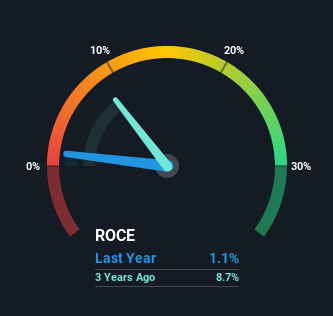- Brazil
- /
- Healthcare Services
- /
- BOVESPA:DASA3
Diagnósticos da América (BVMF:DASA3) Could Be Struggling To Allocate Capital

What are the early trends we should look for to identify a stock that could multiply in value over the long term? Amongst other things, we'll want to see two things; firstly, a growing return on capital employed (ROCE) and secondly, an expansion in the company's amount of capital employed. If you see this, it typically means it's a company with a great business model and plenty of profitable reinvestment opportunities. Although, when we looked at Diagnósticos da América (BVMF:DASA3), it didn't seem to tick all of these boxes.
Return On Capital Employed (ROCE): What is it?
Just to clarify if you're unsure, ROCE is a metric for evaluating how much pre-tax income (in percentage terms) a company earns on the capital invested in its business. The formula for this calculation on Diagnósticos da América is:
Return on Capital Employed = Earnings Before Interest and Tax (EBIT) ÷ (Total Assets - Current Liabilities)
0.011 = R$155m ÷ (R$18b - R$4.9b) (Based on the trailing twelve months to September 2021).
Thus, Diagnósticos da América has an ROCE of 1.1%. In absolute terms, that's a low return and it also under-performs the Healthcare industry average of 11%.
Check out our latest analysis for Diagnósticos da América

In the above chart we have measured Diagnósticos da América's prior ROCE against its prior performance, but the future is arguably more important. If you'd like, you can check out the forecasts from the analysts covering Diagnósticos da América here for free.
What The Trend Of ROCE Can Tell Us
When we looked at the ROCE trend at Diagnósticos da América, we didn't gain much confidence. Around five years ago the returns on capital were 7.4%, but since then they've fallen to 1.1%. Although, given both revenue and the amount of assets employed in the business have increased, it could suggest the company is investing in growth, and the extra capital has led to a short-term reduction in ROCE. If these investments prove successful, this can bode very well for long term stock performance.
While on the subject, we noticed that the ratio of current liabilities to total assets has risen to 26%, which has impacted the ROCE. If current liabilities hadn't increased as much as they did, the ROCE could actually be even lower. While the ratio isn't currently too high, it's worth keeping an eye on this because if it gets particularly high, the business could then face some new elements of risk.
In Conclusion...
Even though returns on capital have fallen in the short term, we find it promising that revenue and capital employed have both increased for Diagnósticos da América. And the stock has followed suit returning a meaningful 55% to shareholders over the last five years. So while investors seem to be recognizing these promising trends, we would look further into this stock to make sure the other metrics justify the positive view.
If you want to know some of the risks facing Diagnósticos da América we've found 3 warning signs (1 makes us a bit uncomfortable!) that you should be aware of before investing here.
While Diagnósticos da América isn't earning the highest return, check out this free list of companies that are earning high returns on equity with solid balance sheets.
New: Manage All Your Stock Portfolios in One Place
We've created the ultimate portfolio companion for stock investors, and it's free.
• Connect an unlimited number of Portfolios and see your total in one currency
• Be alerted to new Warning Signs or Risks via email or mobile
• Track the Fair Value of your stocks
Have feedback on this article? Concerned about the content? Get in touch with us directly. Alternatively, email editorial-team (at) simplywallst.com.
This article by Simply Wall St is general in nature. We provide commentary based on historical data and analyst forecasts only using an unbiased methodology and our articles are not intended to be financial advice. It does not constitute a recommendation to buy or sell any stock, and does not take account of your objectives, or your financial situation. We aim to bring you long-term focused analysis driven by fundamental data. Note that our analysis may not factor in the latest price-sensitive company announcements or qualitative material. Simply Wall St has no position in any stocks mentioned.
About BOVESPA:DASA3
Diagnósticos da América
Provides diagnostic and hospital services in Brazil and Argentina.
Reasonable growth potential and fair value.
Market Insights
Community Narratives



